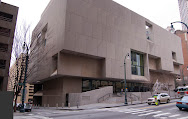Auguste Perret (1874 – 1954) was a French architect who specialized in reinforced concrete construction, known as Béton Brut. Meaning ‘raw concrete”, Béton Brut, aka Brutalism, is an architectural style that was once much beloved. This was especially true in the postwar age, at a time when world leaders, governments and institutions held high hopes for a better life. In rebuilding their nations, these leaders aspired to create more egalitarian societies that were also uniform. And having harnessed the industrial revolution, with the emergence of easy to use, low-cost building materials, structurally sound pre-cast concrete became a favorite for civic revitalization. Most all the great modernists used it, with Le Corbusier, who had been formerly been employed by Mr. Perret, referring to Béton Brut as his “choice material.”
With its grand massing, Brutalism has a visual heft, also conveyed in structural strength. The use of a steel frame, with high grade reinforced concrete for the superstructure, makes these buildings very sound. Another clever aspect of this style is the implementation of accentuated supporting columns, creating distinct design attributes while dually enhancing the buildings durability even further. Indeed, a wise achievement.
Still in recent times, buildings of the Béton Brut age--Modernist and of the International Style--are perceived by some as anything but fabulous; with many of the world’s most iconic structures, like The Atlanta-Fulton Central Public Library, Cleveland’s Ameritrust Tower, New York’s Whitney Museum and Boston’s City Hall having all (at some point) come under critical attack. There are, however, those who beg to differ.
Notably, at ground zero of this ongoing debate on the truth and beauty of concrete modernist structures, a rather high-profile organization calling itself DOCOMOMO, has come of age with local chapters throughout the world. DOCOMOMO is a moniker, which stands for DOcumentation and COnservation of buildings, sites and neighborhoods of the MOdern MOvement. On their (international) website it states that their mission is to:
The World Monuments Fund, as well as The National Trust for Historic Preservation, offers a clear intent to bring attention to buildings of recent history. Too, there are other indications that the currently unappreciated genre of Béton Brut is being revisited, with in 2004 La Centre National de la Danse, a Modernist Béton Brut building located in France, was awarded the Prix d'architecture de l'Équerre d'argent, one of France's most prestigious design awards.
___________________________
.jpg)

